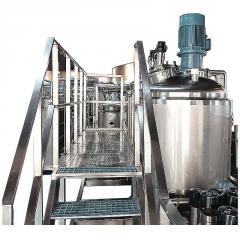
——Analysis of the entire process from bacterial strains to capsules/powders/beverages
1、 Process Overview
Objective: To stably obtain ≥ 1 × 10 ¹¹ CFU/g active probiotic dry powder or its derivatives (capsules, tablets, sachets, fermented beverages) in the cGMP/ISO 22000 system. The entire factory is divided into 6 major modules according to their functions:
① Strain library → ② seed expansion → ③ main fermentation → ④ harvest concentration → ⑤ drying&embedding → ⑥ formulation and packaging.
Typical production capacity: Freeze dried bacterial powder 500-2000 kg/batch, or liquid fermented beverage 5-20 t/batch, with flexible switching.
2、 Core process steps and equipment
1. Strain recovery and seed expansion cultivation
-Microbial library: -80 ℃ glycerol tube → 2-8 ℃ thawing → 10 mL shake flask → 100 mL shake flask → 5 L stirring tank (Sartorius Biostat) ® Aplus or equivalent).
-Key controls: pH 6.2-6.5 (30% NaOH online replenishment), temperature 37 ℃ (± 0.2 ℃), anaerobic N ₂ coverage (0.05 bar positive pressure), dissolved oxygen<0.5 ppm.
-Expansion cycle: 12-16 hours, OD600=6-8 hours, transfer to the tank.
2. Main fermentation (parallel connection of 8 × 10000 L fermentation tanks)
-Tank body: 316L electro polished Ra ≤ 0.4 μ m, aspect ratio 2.5:1, double-layer six blade Rushton propeller+variable frequency speed regulation 50-250 rpm.
-CIP/SIP: Pure steam at 135 ℃ for 30 minutes; 0.22 μ m PTFE sterilization respirator on the top of the tank.
-Online monitoring: BioPAT ® MFCS 4 software records pH, temperature, dissolved oxygen and foam (defoamer 0.1% v/v).
-Bacterial collection index: live bacteria ≥ 1 × 10 ⁹ CFU/mL, total fermentation period 18-24 hours.
3. Harvesting and concentration
-Continuous centrifugation: Disc centrifuge 8000 g, low-temperature collection at 4 ℃, recovery rate>95%.
-Membrane concentration: 0.2 μ m hollow fiber tangential flow filtration (TFF) is used to concentrate the bacterial sludge 10-15 times and replace the culture medium with cryoprotectant (10% skim milk+8% trehalose+2% sodium ascorbate).
4. Drying and embedding
4.1 Freeze drying
-Model: Dara Lyo LyoBiotic batch freeze dryer, 20 m ² shelf, cold trap -55 ℃, ultimate vacuum of 0.05 mbar.
-Curve: Pre freeze at -40 ℃ for 2 hours → primary drying at -10 ℃/0.1 mbar for 12 hours → secondary drying at 25 ℃/0.05 mbar for 4 hours.
-The moisture content of the powder is ≤ 3%, and the retention rate of live bacteria is 80-90%.
4.2 Fluidized bed embedding (optional)
-Wurster bottom spray coating machine, HPMC/insect glue/lipid double-layer coating, improves gastric acid tolerance by 1000 times.
5. Preparations and packaging
-Dry direct pressing: Rotary tablet press 55 kN, tablet weight 500 mg, hardness 80-100 N.
-Capsule filling: NJP-800 fully automatic capsule machine, filling amount 250-500 mg, filling amount difference ± 3%.
-Strip shaped small bag: Four sided sealed powder packaging machine with 60 bags/min, filled with nitrogen and residual oxygen<1%.
-Fermented beverage line: UHT 95 ℃/30 s → Aseptic tank → Inoculation at 30 ℃ → Fermentation for 4 hours to pH 4.2 → Aseptic cold filling of 125 mL PET bottles, with viable bacteria ≥ 1 × 10 ⁸ CFU/mL.
3、 Automation and Quality Systems
-Central DCS+MES: Batch tracking, electronic signature, audit tracking (21 CFR Part 11).
-QC laboratory:
-Live bacteria counting: Anaerobic workstation 37 ℃ 48 h pouring method;
-Rapid detection: Flow cytometry completes the percentage of active/dead bacteria within 15 minutes;
-Stability: Accelerated at 40 ℃/75% RH for 3 months, with a decrease in viable bacteria<1 log.
-Cross contamination control: physical isolation between bacterial strains, independent air conditioning system, three-level changing room+airlock room.
4、 Examples of Public Works and Capacity
-Steam: 1.5 t/h @ 6 bar, pure steam generator for SIP;
-Ice water: -5 ℃ ethylene glycol 40 m ³/h, used for constant temperature in fermentation tanks;
-Compressed air: oil-free 0.8 MPa, filtered through 0.01 μ m sterilization;
-Annual production capacity: 200 tons of freeze-dried bacterial powder (or 30000 tons of fermented beverages), equipment utilization rate of 75%.
V. Conclusion
The probiotic production line is centered around "modularity, flexibility, and digitization", and can produce three categories of highly active freeze-dried powder for human use, animal feed microbial agents, and fermented functional beverages, with hundreds of SKUs. The investment return period (IRR) is about 3.8 years, providing a solid platform for entering the global probiotic market worth billions.












